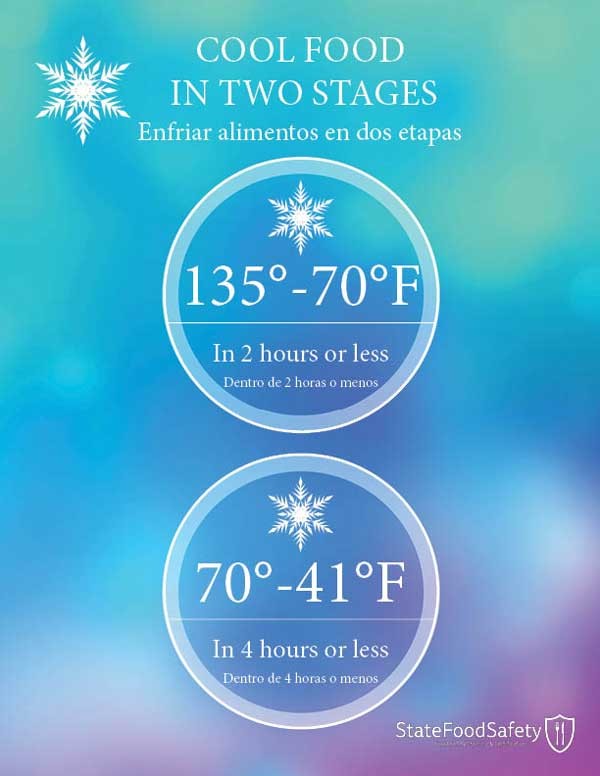Cooling food properly is just as crucial as cooking it thoroughly when it comes to food safety. While cooking often takes center stage, the cooling process, especially when A Food Worker Cools A Batch Of Chicken, deserves equal attention to prevent bacterial growth and ensure safe consumption.
Image: A commercial kitchen blast chiller used by a food worker to rapidly cool food.
The Two-Stage Cooling Method: A Critical Process
The FDA sets forth stringent guidelines for cooling food, often referred to as the two-stage cooling process. This process is paramount, especially when a food worker cools a batch of chicken, as it directly impacts the safety of the food. Understanding and adhering to these regulations is vital for all food handlers.
The FDA recommends cooling food from 135°F (57°C) to 41°F (5°C) within six hours to inhibit dangerous bacterial proliferation. However, the guidelines go further: food must be cooled from 135°F (57°C) to 70°F (21°C) in two hours or less. This initial stage is critical because bacteria can multiply rapidly within this temperature range, sometimes doubling in as little as 20 minutes. The faster a food worker cools a batch of chicken through this range, the safer it becomes. After this initial rapid cooling, the food worker has the remaining four hours to lower the temperature from 70°F (21°C) to 41°F (5°C).
This entire process is divided into two manageable stages:
- Stage 1: Cool food from 135°F (57°C) to 70°F (21°C) in two hours.
- Stage 2: Cool food from 70°F (21°C) to 41°F (5°C) in four hours.
Training and Understanding: Empowering Food Workers
While breaking down the cooling guidelines into two stages simplifies the process, proper training is essential. When a food worker cools a batch of chicken, they need to understand the importance of each stage and the potential consequences of not adhering to the time limits. Misunderstandings can lead to unsafe cooling practices, such as spending too long in the initial, most dangerous temperature range.
It’s crucial for food workers to grasp the why behind the rules. Understanding the temperature danger zone and the rapid bacterial growth within it motivates adherence to safe cooling procedures. Comprehensive training should be part of every food safety manager certification.
The Temperature Danger Zone: Understanding the Risk
The temperature range between 135°F (57°C) and 41°F (5°C) is known as the temperature danger zone because bacteria thrive within it. This is why rapid cooling is essential, particularly when a food worker cools a batch of chicken.
Image: A food safety poster illustrating the two-stage cooling process for food.
As food cools, it passes through this zone, providing a window for bacterial multiplication. If cooked food is left out to cool slowly, it can become unsafe within hours. Proper cooling methods control bacterial growth and minimize the risk of foodborne illness.
Effective Cooling Methods for Chicken and Other Foods
Cooling large batches of hot food, like chicken, requires strategic approaches. Here are several effective methods:
- Portioning: Divide the cooked chicken into smaller, shallower containers (4 inches deep or less). This allows for faster and more even cooling. Large pots retain heat, especially in the center, which can prolong the time spent in the temperature danger zone.
- Loose Covering: Cover the chicken loosely while it cools in the refrigerator. This allows heat to escape more easily. If the food is adequately protected from overhead contamination, it can be left uncovered.
- Stirring: For loose foods like soups or sauces, stir frequently to distribute heat evenly. This isn’t applicable for solid dishes like casseroles.
- Ice Bath: Place the container of chicken in an ice water bath, ensuring the water level is above the food level. This helps to rapidly cool the food.
- Ice as an Ingredient: For liquid dishes, consider adding ice as an ingredient to speed up the cooling process.
- Blast Chiller: Utilize a blast chiller, a specialized appliance designed for rapid cooling of large quantities of food. This is one of the fastest and most efficient methods, particularly when a food worker cools a batch of chicken in a commercial setting.
Conclusion: Prioritizing Safe Cooling Practices
Properly cooling cooked food, especially when a food worker cools a batch of chicken, is a critical step in preventing foodborne illnesses. Adhering to the FDA’s two-stage cooling process and employing effective cooling methods ensures that food passes through the temperature danger zone quickly, minimizing bacterial growth and maintaining food safety. By prioritizing training and understanding the principles behind safe cooling practices, food workers can confidently protect public health and serve safe, delicious meals.

